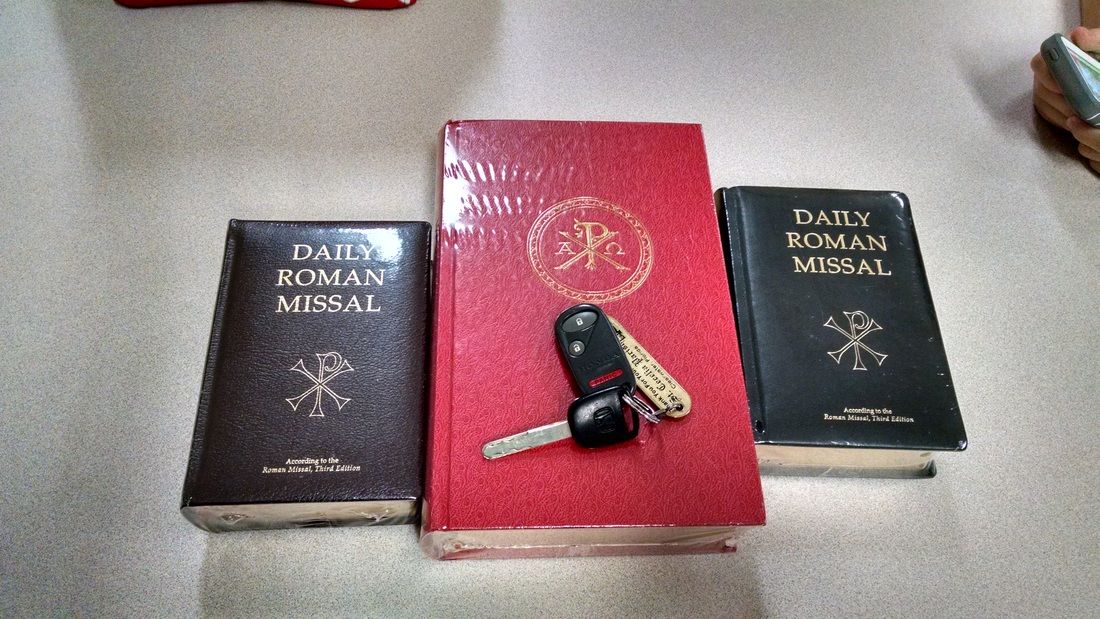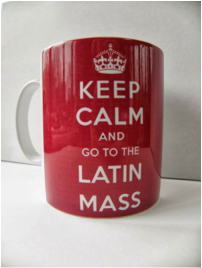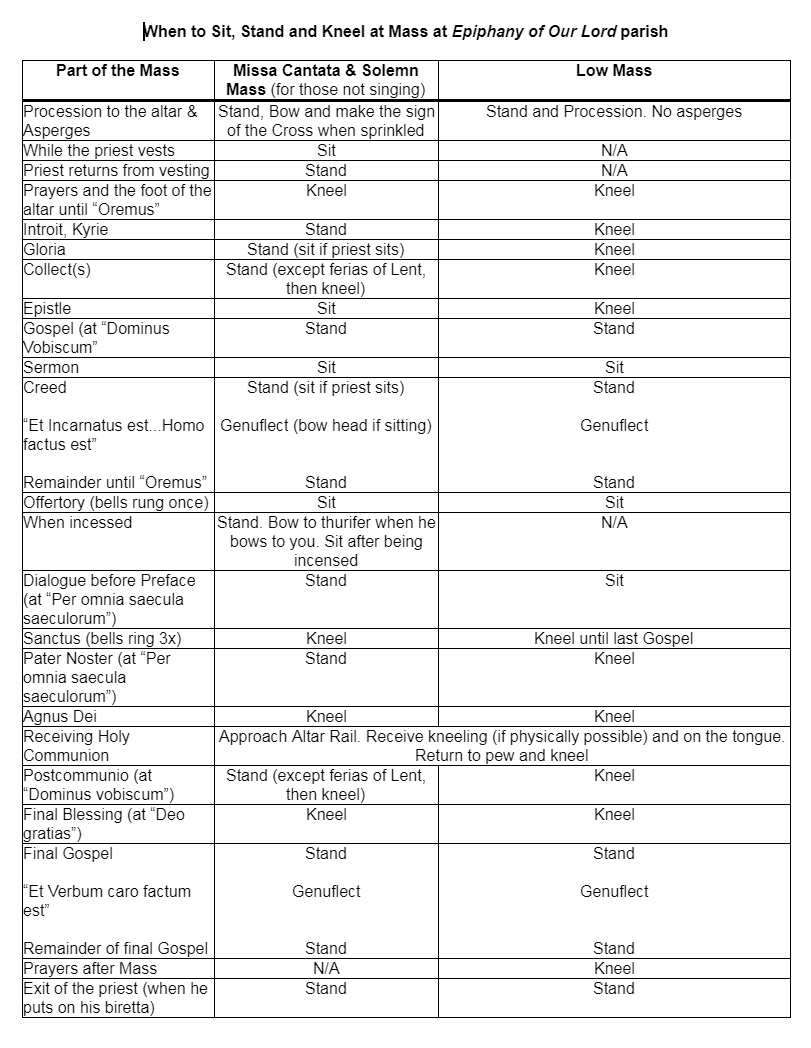The Traditional Latin Mass calendar is different than the calendar for the "ordinary" Mass. Checking the familiar throwaway pew missalette and trying to match it with your new 1962 Missal will not work. Below is a guide for which Mass is being celebrated. Scroll through to the date you are looking for. Many days the priest has the option to choose which Mass to celebrate and we have listed Father's choice for Epiphany. He reserves the right to change it if needed, though, if, for instance, we would need to celebrate a Mass for a new Pope being elected or something like that. Scroll down further on the page to see a chart of when to sit, stand, genuflect and kneel at Mass, too. Note that there are differences in that regard between the Low and High Masses.
|
This is the "key" to finding the Mass in the Missal. Each missal has different page numbers so those are not included. Daily Mass often goes by the date and can (usually) be found in the back half of the book. Sundays are usually found in the front part of the book.
["comm:" shows that we "commemorate" another Saint or two by adding three prayers to the "regular" day's prayers. These are the "collect" the "secret" and the "postcommunion" prayers.] |
Strike the webmaster three times while reading the above captions!
|
May 2024
- Wed St. Joseph the Workman
- Thurs St. Athanasius
- Fri SS. Alexander & Companions
- Sat St. Monica
- Sun Fifth Sunday after Easter
- Mon Feria of the Paschaltide
- Tues St. Stanislaus
- Wed Vigil of the Ascension
- Thurs Ascension of the Lord (Not a Holy Day of Obligation)
- Fri St. Antoninus, Comm: SS. Gordian & Epimachus
- Sat SS. Philip & St. James
- Sun Sunday after the Ascension
- Mon St. Robert Bellarmine
- Tues St. Boniface
- Wed St. John the Baptist de la Salle
- Thurs St. Ubald
- Fri St. Paschal Baylon
- Sat Vigil of Pentecost
- Sun Pentecost Sunday Note: Kneel at the Veni, Sancte Spiritus of the Alleluia verse on Pentecost and during the octave (when sung by the choir at High Mass; or, when read at Low Mass)
- Mon Pentecost Monday
- Tues Pentecost Tuesday
- Wed Pentecost Wednesday (Ember Day) [680] {355}
- Thurs Pentecost Thursday
- Fri Pentecost Friday (Ember Day) [685] {358}
- Sat Pentecost Saturday (Ember Day) [688] {360}
- Sun Trinity Sunday [696] {366}
- Mon St. Bede the Venerable, Comm: St. John I
- Tues St. Augustine of Canterbury
- Wed St. Mary Magdalene of Pazzi
- Thurs Corpus Christi [705] {369}
- Fri Queenship of Mary
Numbers in [brackets] indicate page numbers in the Angelus Press Daily Missal for hard-to-find Masses.
Numbers in {brackets} indicate page numbers in the altar Missal.
June 2024
- Sat St. Angela Merici
- Sun External Solemnity of Corpus Christi [705] {369}
- Mon Feria
- Tues St. Francis Caracciolo
- Wed St. Boniface
- Thurs St. Norbert
- Fri Sacred Heart of Jesus [719] {373} Plenary indulgence: saying publicly The Act of Reparation to the Sacred Heart of Jesus in front of the Blessed Sacrament
- Sat Saturday of Our Lady
- Sun External Solemnity of the Sacred Heart of Jesus [719] {373}
- Mon St. Margaret, Queen of Scotland
- Tues St. Barnabas
- Wed St. John of San Fecundo, Comm: SS. Basilidis, Cyrinus, Nabor & Nazarius
- Thurs St. Anthony of Padua
- Fri St. Basil the Great
- Sat Our Lady on Saturday [Mass 5 of BVM, 1035] {(50)}
- Sun 4th Sunday after Pentecost
- Mon St. Gregory Barbarigo
- Tues St. Ephraem Syrus, Comm: SS. Mark & Marcellianus
- Wed St. Julia of Falconieri, Comm: SS. Gervase & Prostase
- Thurs St. Silverius
- Fri St. Aloysius Gonzaga
- Sat St. Paulinus of Nola
- Sun 5th Sunday after Pentecost, Comm: Vigil of the Nativity of St. John the Baptist [Blessing of a bonfire]
- Mon Nativity of St. John the Baptist
- Tues St. William, Abbot
- Wed SS. John & Paul
- Thurs Our Lady of Perpetual Help [1672] {(183)}
- Fri Vigil of SS. Peter & Paul
- Sat SS. Peter & Paul
- Sun 6th Sunday after Pentecost
Numbers in [brackets] indicate page numbers in the Angelus Press Daily Missal for hard-to-find Masses. Numbers in {brackets} indicate page numbers in the altar Missal.
** In parishes where the faithful are accustomed to stand for the Collects and Post-Communion prayers at Mass, they should be instructed to kneel for these prayers on the ferias of Advent (not, however, on Sundays, feast days, or the Vigil of Christmas).




